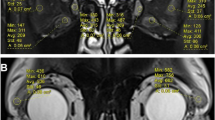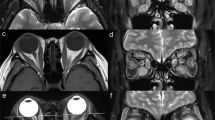Abstract
Purpose
To evaluate the validity of using quantitative volume and density measurements from orbital computed tomography (CT) images to assess the inflammatory activity of patients with thyroid-associated orbitopathy (TAO).
Methods
Computed tomography (CT) scans were obtained from 80 TAO patients and 40 controls, and 3D image analysis was conducted to measure the volume and density (in HU units) of intraorbital and extraorbital fat, extraocular muscle (EOM), and the lacrimal gland. Volume and density measurements of the orbital tissues were compared among active TAO, inactive TAO, and control subjects by ANCOVA. To determine the predictive value of each parameter for TAO activity, logistic regression was performed.
Results
The mean volume of extraorbital and intraorbital fat was significantly higher in patients with TAO than controls (p = 0.0019, p = 0.0004), with no significant difference between active and inactive TAO subjects. The mean total EOM volume and lacrimal gland volume was greater in active TAO patients than other groups (p < 0.0001, p < 0.0001). The mean density of extraorbital fat and the lacrimal gland was significantly different between active TAO, inactive TAO, and control groups (p = 0.0002, and p = 0.0487, respectively). Regression models incorporating total EOM volume, lacrimal gland volume, intraorbital fat volume, and density of extraorbital fat and the lacrimal gland could predict active inflammation in patients with TAO with accuracy of 84.5 %.
Conclusions
The measurements of orbital soft tissue volume and density using CT scans can be used as a reliable and feasible technique to establish active inflammation in patients with TAO.



Similar content being viewed by others

References
Jacobson DH, Gorman CA (1984) Endocrine ophthalmopathy: current ideas concerning etiology, pathogenesis, and treatment. Endocr Rev 5:200–220
Dickinson AJ, Perros P (2001) Controversies in the clinical evaluation of active thyroid-associated orbitopathy: use of a detailed protocol with comparative photographs for objective assessment. Clin Endocrinol (Oxf) 55:283–303
Regensburg NI, Kok PH, Zonneveld FW, Baldeschi L, Saeed P, Wiersinga WM, Mourits MP (2008) A new and validated CT-based method for the calculation of orbital soft tissue volumes. Investig Ophthalmol Vis Sci 49:1758–1762
Hallin ES, Feldon SE (1988) Graves’ ophthalmopathy: II. Correlation of clinical signs with measures derived from computed tomography. Br J Ophthalmol 72(9):678–82
Feldon SE, Lee CP, Muramatsu SK, Weiner JM (1985) Quantitative computed tomography of Graves’ ophthalmopathy. Extraocular muscle and orbital fat in development of optic neuropathy. Arch Ophthalmol 103(2):213–5
Ozgen A, Alp MN, Ariyurek M, Tutuncu NB, Can I, Gunalp I (1999) Quantitative CT of the orbit in Graves’ disease. Br J Radiol 72(860):757–62
Souza AD, Ruiz EE, Cruz AA (2007) Extraocular muscle quantification using mathematical morphology: a semi-automatic method for analyzing muscle enlargement in orbital diseases. Comput Med Imaging Graph 31(1):39–45
Regensburg NI, Wiersinga WM, Berendschot TT, Saeed P, Mourits MP (2011) Densities of orbital fat and extraocular muscles in graves orbitopathy patients and controls. Ophthal Plast Reconstr Surg 27(4):236–40
Barras CD, Tress BM, Christensen S, Collins M, Desmond PM, Skolnick BE, Mayer SA, Davis SM, Recombinant Activated Factor VII Intracerebral hemorrhage Trial investigators (2013) Quantitative CT densitometry for predicting intracerebral hemorrhage growth. AJNR Am J Neuroradiol 34(6):1139–44
Ahmadi N, Hajsadeghi F, Conneely M, Mingos M, Arora R, Budoff M, Ebrahimi R (2013) Accurate detection of metabolically active “brown” and “white” adipost tissues with computed tomography. Acad Radiol 20(11):1443–7
Bartley GB, Gorman CA (1995) Diagnostic criteria for Graves’ ophthalmopathy. Am J Ophthalmol 119(6):792–5
Mourits MP, Prummel MF, Wiersinga WM, Koornneef L (1997) Clinical activity score as a guide in the management of patients with Graves’ ophthalmopathy. Clin Endocrinol (Oxf) 47(1):9–14
Goncalves AC, Silva LN, Gebrim EM, Monteiro ML (2012) Quantification of orbital apex crowding for screening of dysthyroid optic neuropathy using multidetector CT. AJNR Am J Neuroradiol 33(8):1602–7
Goncalves AC, Silva LN, Gebrim EM, Matayoshi S, Monteiro ML (2012) Predicting dysthyroid optic neuropathy using computed tomography volumetric analyses of orbital structures. Clinics (Sao Paulo) 67(8):891–6
Yamamoto K, Itoh K, Yoshida S, Saito K, Sakamoto Y, Matsuda A, Saito T, Kuzuya T (1979) A quantitative analysis of orbital soft tissue in Graves’ disease based on B-mode ultrasonography. Endocrinol Jpn 26(2):255–61
Harris MA, Realini T, Hogg JP, Sivak-Callcott JA (2012) CT dimensions of the lacrimal gland in Graves orbitopathy. Ophthal Plast Reconstr Surg 28(1):69–72
Weis E, Heran MK, Jhamb A, Chan AK, Chiu JP, Hurley MC, Rootman J (2012) Quantitative computed tomographic predictors of compressive optic neuropathy in patients with thyroid orbitopathy: a volumetric analysis. Ophthalmology 119(10):2174–8
Eckstein AK, Finkenrath A, Heiligenhaus A, Renzing-Kohler K, Esser J, Kruger C, Quadbeck B, Steuhl KP, Gieseler RK (2004) Dry eye syndrome in thyroid-associated ophthalmopathy: lacrimal expression of TSH receptor suggests involvement of TSHR-specific autoantibodies. Acta Ophthalmol Scand 82(3 Pt 1):291–7
Huang D, Luo Q, Yang H, Mao Y (2014) Changes of lacrimal gland and tear inflammatory cytokines in thyroid-associated ophthalmopathy. Invest Ophthalmol Vis Sci 55(8):4935–43
Bingham CM, Harris MA, Realini T, Nguyen J, Hogg JP, Sivak-Callcott JA (2014) Calculated computed tomography volumes of lacrimal glands and comparison to clinical findings in patients with thyroid eye disease. Ophthal Plast Reconstr Surg 30(2):116–8
Wiersinga WM, Regensburg NI, Mourits MP (2013) Differential involvement of orbital fat and extraocular muscles in graves’ ophthalmopathy. Eur Thyroid J 2(1):14–21
Weetman AP, Cohen S, Gatter KC, Fells P, Shine B (1989) Immunohistochemical analysis of the retrobulbar tissues in Graves’ ophthalmopathy. Clin Exp Immunol 75(2):222–7
Al-Bakri M, Rasmussen AK, Thomsen C, Toft PB (2014) Orbital volumetry in Graves’ orbitopathy: muscle and fat involvement in relation to dysthyroid optic neuropathy. ISRN Ophthalmol 2014:435276
Kvetny J, Puhakka KB, Rohl L (2006) Magnetic resonance imaging determination of extraocular eye muscle volume in patients with thyroid-associated ophthalmopathy and proptosis. Acta Ophthalmol Scand 84(3):419–23
Trokel SL, Jakobiec FA (1981) Correlation of CT scanning and pathologic features of ophthalmic Graves’ disease. Ophthalmology 88(6):553–64
Uhlenbrock D (1988) Computed tomography in Graves’ ophthalmopathy—evaluation regarding the muscle size and density units. Neurosurg Rev 11(1):45–51
Hiromatsu Y, Yang D, Bednarczuk T, Miyake I, Nonaka K, Inoue Y (2000) Cytokine profiles in eye muscle tissue and orbital fat tissue from patients with thyroid-associated ophthalmopathy. J Clin Endocrinol Metab 85(3):1194–9
Forbes G, Gorman CA, Brennan MD, Gehring DG, Ilstrup DM, Earnest F 4th (1986) Ophthalmopathy of Graves’ disease: computerized volume measurements of the orbital fat and muscle. AJNR Am J Neuroradiol 7(4):651–6
Nunery WR, Martin RT, Heinz GW, Gavin TJ (1993) The association of cigarette smoking with clinical subtypes of ophthalmic Graves’ disease. Ophthal Plast Reconstr Surg 9(2):77–82
Author information
Authors and Affiliations
Corresponding author
Ethics declarations
Funding
This research was supported by Basic Science Research Program through the National Research foundation of Korea (NRF) funded by the Ministry of Education (NRF-2015R1D1A1A01060016). The sponsor had no role in the design or conduct of this study.
Conflict of interest
All authors certify that they have no affiliations with or involvement in any organization or entity with any financial interest (such as honoraria; educational grants; participation in speaker’s bureaus; membership, employment, consultancies, stock ownership, or other equity interest; and expert testimony or patient-licensing arrangements), or non-financial interest (such as personal or professional relationships, affiliations, knowledge, or beliefs) in the subject matter of materials discussed in this manuscript.
Ethical approval
All procedures performed in studies involving human participants were in accordance with ethical standards of the institutional and/or national research committee and with the 1964 Helsinki Declaration and its later amendments or comparable ethical standards. For this type of study formal consent is not required.
Rights and permissions
About this article
Cite this article
Byun, J.S., Moon, N.J. & Lee, J.K. Quantitative analysis of orbital soft tissues on computed tomography to assess the activity of thyroid-associated orbitopathy. Graefes Arch Clin Exp Ophthalmol 255, 413–420 (2017). https://doi.org/10.1007/s00417-016-3538-0
Received:
Revised:
Accepted:
Published:
Issue Date:
DOI: https://doi.org/10.1007/s00417-016-3538-0



